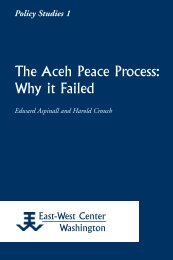Constructing Papuan Nationalism: History, Ethnicity ... - ScholarSpace
Constructing Papuan Nationalism: History, Ethnicity ... - ScholarSpace
Constructing Papuan Nationalism: History, Ethnicity ... - ScholarSpace
- No tags were found...
Create successful ePaper yourself
Turn your PDF publications into a flip-book with our unique Google optimized e-Paper software.
<strong>Constructing</strong> <strong>Papuan</strong> <strong>Nationalism</strong> 63has remained distinctive in the <strong>Papuan</strong> context, due largely to its religiouscomplexion and strong links to neighboring Maluku. In Fakfak, the choicebetween identification with Indonesia (through Maluku) and with Papuaremains highly contested, with different parts of the Fakfak communitymaking different choices. Meanwhile, the pro-Indonesia political orientationthat once made Serui so distinctive in Papua has faded. Beginning inthe early 1960s with the rise of Serui leaders in the nationalist PARNAparty, and intensifying by 1969 with the alienation from Indonesia generatedby the conduct of the “Act of Free Choice,” Serui has come to reflectmuch more the <strong>Papuan</strong> political mainstream.Fakfak – The Struggle between <strong>Papuan</strong> and Indonesian IdentitiesThe region around Fakfak, on the southwestern coast of Papua, has a longhistory of interaction with the outside world that distinguishes it frommany other regions of Papua. This history, together with their family, religious,and economic ties with the neighboring islands of central Maluku,has given Muslim <strong>Papuan</strong>s in Fakfak choicesbetween <strong>Papuan</strong> and Indonesian identities andthe different political orientations that flow fromthem. This section explores the history of thosedynamics, and details how they have been playingout in recent political activity. It will be arguedthat, as elsewhere in Papua, there is no simple correlationbetween religious belief and political orientation in Fakfak. Thissketch of Fakfak’s recent political history suggests how history can shape therange of alternatives, while not determining the outcomes.Muslim <strong>Papuan</strong>s inFakfak [had] choicesbetween <strong>Papuan</strong> andIndonesian identitiesFakfak as Muslim PapuaThe coast where Fakfak is located is geographically proximate to theislands of central Maluku, particularly east Ceram, Ceram Laut, andGoram. From the sixteenth century the region was part of an extensivetrading network that extended through the archipelago and intoMelanesia. Textiles, beads, and other products were traded for <strong>Papuan</strong>slaves and forest products, including timber and bark from the masooi tree.Fortified trading settlements, called sosolot, were established along thecoast where Ceramese traders established local monopolies and intermarriedwith local communities. The Muslim leaders of these communitiesbore the title Raja, in the manner of village leaders in central Maluku.Though they had some <strong>Papuan</strong> ancestry, they also had strong family links
















